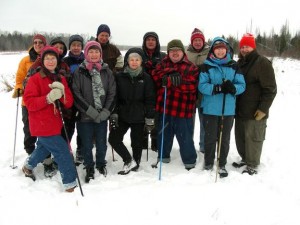Door to Nature
- Share
- Tweet
- Pin
- Share

The students in Roy’s Reading the Winter Landscape Clearing class gather on the Mink River during their hike on January 15th. Photo by Roy Lukes.
Winter hikes have really appealed to me ever since childhood, growing up in Kewaunee, when one day in January of 1937 my dad drove my two older brothers and me out to Seidel’s Lake a few miles southwest of the city. Quite often that small, mostly bog-surrounded glacial lake was protected from wind making the ice mirror-like for wonderful skating, and we all dearly loved ice-skating.
The surrounding woods provided us with some good hikes, too, however with our having to promise dad that we’d never venture onto the dangerous quaking bog in summer. Naturally we did, but that’s another story.
Many cold, cheek-stinging adventures along the Lake Michigan shore north and especially south of Kewaunee proved to be among our favorites because of the dazzling ice build-up produced by the crashing waves. My best boyhood buddy, Tony Kotyza, and I came to know practically every inch of the woods bordering the Kewaunee River for several miles during all seasons. Even though we didn’t know one plant or bird from another at our young age, the spark was ignited for both of us. Eventually higher education, both of us in the teaching field, set us onto the right path.
Today, January 15, my Clearing-in-Winter “Reading the Winter Landscape” class of 12 adults had a long exhilarating hike that took us from The Nature Conservancy’s trailhead entrance on the east side of Mink River Road, south of Ellison Bay, all the way through upland mixed hardwoods and low cedar swamps to the Mink River. Hike this same trail in summer and you are guaranteed to have a lot of company, mostly mosquitoes and deer flies.
Even though there was a very good snow cover in the woods, the many Eastern Hemlock trees intercepted a surprisingly large amount of the snow thereby preventing it from reaching the ground. This in turn allowed us to locate quite a few plants, such as the attractive spore cases of the Sensitive and the Ostrich Ferns, several kinds of clubmosses and even the very tiny Dwarf Scouring Rush, to identify and enjoy.
Seed pods of various wild plants were sure to be located and inspected during our exploratory outing. Fortunately many small wild flowering plants produce their seed pods on durable stems which are tall enough to be held above the snow. It’s pure satisfaction to be able to look at the dried remains of a blossoming plant and know the flower that produced it. An older book I highly recommend, Pods: Wildflowers and Weeds in their Final Beauty, was written by Jane Embertson and can help greatly to identify many wild plants in their winter dress.
Come to know the plants both in their summer blossoming periods and their stark winter seed-scattering stages and hikes into the wild take on so much more meaning and enjoyment, making you feel as though you are a genuine partner in nature. Every time I ponder over this point I am reminded of one of my favorite sayings of John Muir, something to the effect that “Going out into the woods is like coming home.”
Muir also declared that: “The clearest way into the Universe is through a forest wilderness.” Indeed, we were in a forest wilderness today, even though these woods had through the years yielded many cedar logs for shingles and telegraph poles, along with maple, beech and ash logs for sawing into lumber or for cutting and splitting into firewood.
Trees captured a lot of our attention during the hike. Identifying the trees by their bark can be a good challenge. Wherever substantial openings were produced during logging operations in past years, there we came upon nice stands of one of the pioneer trees, the Large-toothed Aspen. It was my friend and mentor of years back, Miss Emma Toft, who threw an interesting tree identification challenge at me, one that I chose to test my dozen class members with too on this brisk winter morning.
It was while hiking along the South Trail at Toft Point that Emma and I came to an area of some large mature aspens. Suddenly Emma said, “Roy, without looking up at the crown of this tree, can you tell me what it is?” The bark was quite deeply fissured leading me to guess – Northern Red Oak. Immediately a smile came onto Emma’s face, one that I had come to know, meaning: “I got you this time!” “Now you may look upward at the higher trunk and branches,” she said. The rich olive-colored smooth bark was a give-away – a Large-toothed Aspen. And just as I had expected, my class today enjoyed the identical challenge and good learning experience I did years back under Emma’s teaching!
Gradually day by day, year by year these preserved woods along the Mink River watershed are yielding an increasing amount of biodiversity including salamanders, toads, snakes, frogs, dragonflies, ferns, clubmosses, lichens, wildflowers, trees and shrubs, and a multitude of other native organisms.
We in a sense had these wild woods all to ourselves today. There were times when we paused momentarily to enjoy some discovery that, other than our voices, not a single man-made sound could be heard – no cars, trucks, planes, chainsaws, or snowmobiles included. How fortunate we all are to have these wonderful mini-wildernesses to enjoy, to learn from and to savor. Let’s work hard to keep them so!




